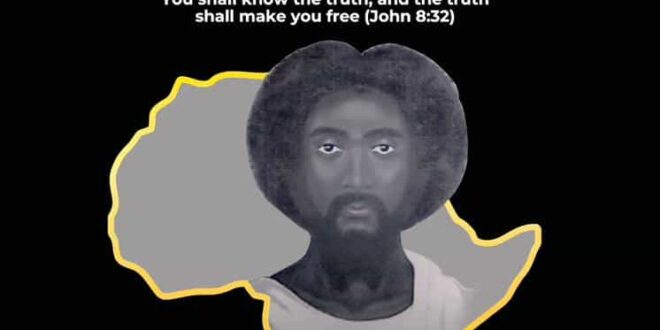… Nigerian Author Sparks Global Debate, Reveals ‘Historical Whitewashing of Jesus‘
In a world where religious imagery has shaped global perceptions of faith, Nigerian author T.C. Wanyanwu has ignited a powerful conversation with his book, Jesus Is a Black Man: An Inconvenient Truth. The thought-provoking title alone has stirred intense debate, challenging centuries-old portrayals of Jesus Christ as a white European figure.
Published in 2016, this book is not merely an academic or theological discourse—it is a bold reexamination of historical, scientific, and biblical narratives that question the dominant visual representation of Christianity’s central figure. Wanyanwu, deeply moved by a spiritual revelation during a 21-day fast, presents a compelling argument against what he describes as the widespread deception surrounding the image of Jesus Christ.
The Journey Behind the Book
Wanyanwu’s inspiration for writing the book was deeply personal. Growing up in West Africa, he witnessed firsthand the impact of idolatry and the veneration of false images. His ancestors, serving as chief priests, engaged in rituals that, he believes, brought spiritual oppression rather than enlightenment. His journey of faith led him to question not just traditional African idol worship but also the pervasive Eurocentric imagery of Jesus seen in churches across the world.
During his fast, he felt a divine calling to expose what he sees as the misrepresentation of Christ’s identity. He argues that idolatry extends beyond statues and pagan practices—it also includes the worship of a distorted image of Jesus that does not reflect historical reality.
Unpacking the Evidence: The Chapters That Challenge History
The book is structured in a way that systematically dismantles the traditional portrayal of Jesus, offering arguments rooted in historical research, biblical interpretation, forensic science, and sociopolitical analysis.
• Chapter 1: The Jewish Background of Jesus – Examines Jesus’ Middle Eastern heritage and the physical characteristics of ancient Jews.
• Chapter 2: Blacks Are the True Jews of the Bible – Presents arguments that link African and Afro-Semitic identities to the original Israelites.
• Chapter 3: Historical References and Proof of Jesus’ Skin Color and Race – Cites ancient descriptions, archaeological findings, and artistic representations of early Christianity.
• Chapter 4: Forensic and Scientific Proof That the Messiah Was Black – Analyzes anthropological and genetic studies related to ancient Middle Eastern populations.
• Chapter 5: The Account of Cesare Borgia (Fake Images of Jesus) – Delves into how Renaissance art, particularly images modeled after Cesare Borgia, contributed to the whitewashing of Jesus.
• Chapter 6: The Biblical Proof That the Messiah Is Black – References scriptural passages that suggest a non-European identity for Jesus.
• Chapter 7: False Image of Christ in Churches, The Conspiracy and Deception Theory – Investigates how political and religious authorities perpetuated the white image of Jesus for control.
• Chapter 8: Jesus Wasn’t White and Why That Matters – Discusses the psychological, cultural, and spiritual implications of a Eurocentric Jesus on black identity and self-worth.
A Psychological and Cultural Crisis
One of Wanyanwu’s most striking arguments highlights the psychological impact of racialized religious imagery. He references the famous 1940s “Doll Test” conducted by Drs. Kenneth and Mamie Clark, which revealed that black children, when given a choice between black and white dolls, often preferred the white dolls and associated them with positive traits.
This internalized belief in white superiority, Wanyanwu argues, extends into religion, where millions of black Christians worship an image of Jesus that looks nothing like them. He questions, “How can black children grow up with self-love when even their God has been presented in an image that does not resemble them?”
The Historical Whitewashing of Jesus
The book also references Susannah Herschel’s The Aryan Jesus, which details how Nazi Germany attempted to strip Jesus of his Jewish identity to fit an Aryan narrative. Similarly, Aylmer von Fleischer’s How Jesus Christ Became White attributes the modern white image of Christ to Renaissance artist Michelangelo, who allegedly used his cousin as the model for Jesus in the famous Sistine Chapel paintings.
Wanyanwu argues that this rebranding of Jesus was not accidental but a deliberate effort by European powers to consolidate religious, cultural, and political dominance.
The Implications of a Black Jesus
The author insists that his book is not about racial supremacy but about restoring historical truth. “This isn’t just about proving Jesus was black—it’s about breaking centuries of deception and allowing people, especially black Christians, to see themselves in their faith.”
He contends that the insistence on a white Jesus has far-reaching consequences, from reinforcing racial hierarchies to distorting the core messages of Christianity. He believes that accepting the true identity of Christ could inspire a renewed sense of dignity and empowerment among black people worldwide.
A Call to Re-Examine Faith and History
Jesus Is a Black Man: An Inconvenient Truth is more than a book—it is a movement urging believers to question inherited narratives and seek the unfiltered truth. Wanyanwu challenges religious institutions, theologians, and everyday Christians to confront the uncomfortable reality of how race and power have shaped faith.
As conversations surrounding race, identity, and religion continue to evolve, this book has positioned itself at the center of a necessary and overdue debate. Whether one agrees or disagrees with Wanyanwu’s arguments, his work forces readers to ask: Why has history been rewritten, and who benefits from the deception?
Questions That Demand Answers
Wanyanwu leaves readers with two haunting questions that challenge both faith and historical narratives:
• What if the world has been waiting for the wrong Messiah?
• If Jesus’ color doesn’t matter, why are some people so upset at the idea of Him being black?
These questions are more than rhetorical—they demand deep introspection. If Jesus truly transcends race, then why has his image been so carefully controlled and curated? And if race is irrelevant to faith, why does the suggestion of a black Jesus stir such controversy?
This book is not just an inconvenient truth—it is a revolutionary call for spiritual and historical clarity.
 PH Mundial – Port Harcourt Online Newspaper News Across The Region
PH Mundial – Port Harcourt Online Newspaper News Across The Region










